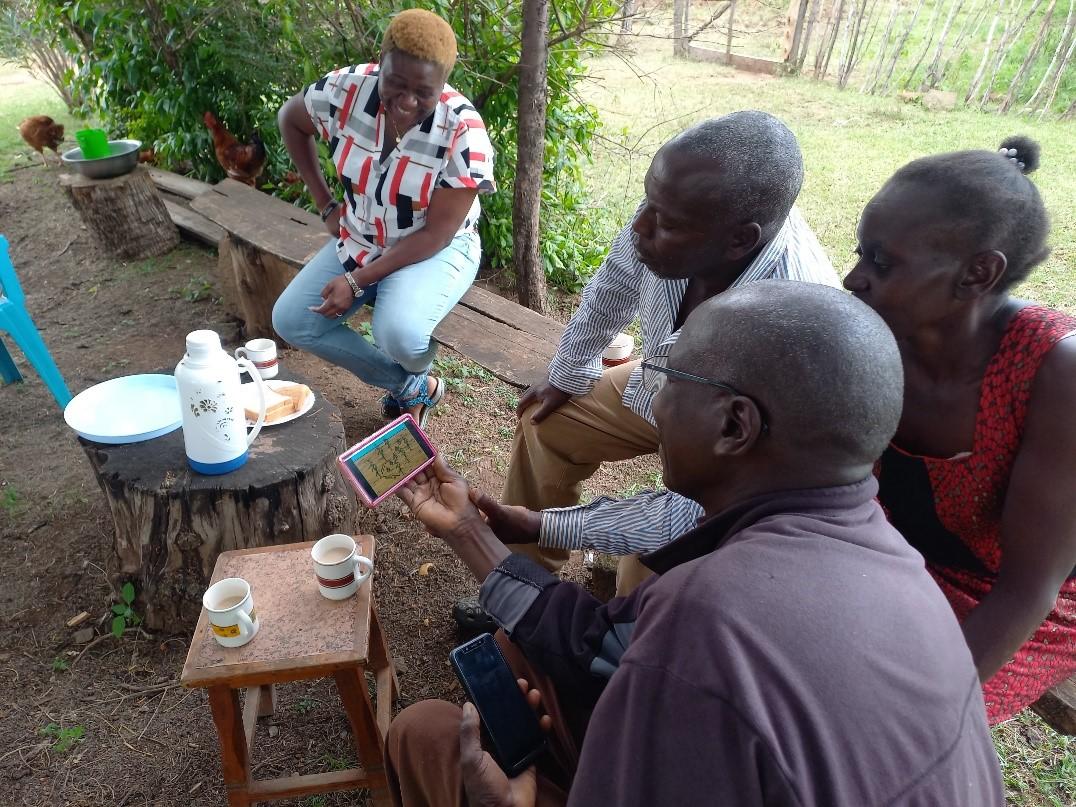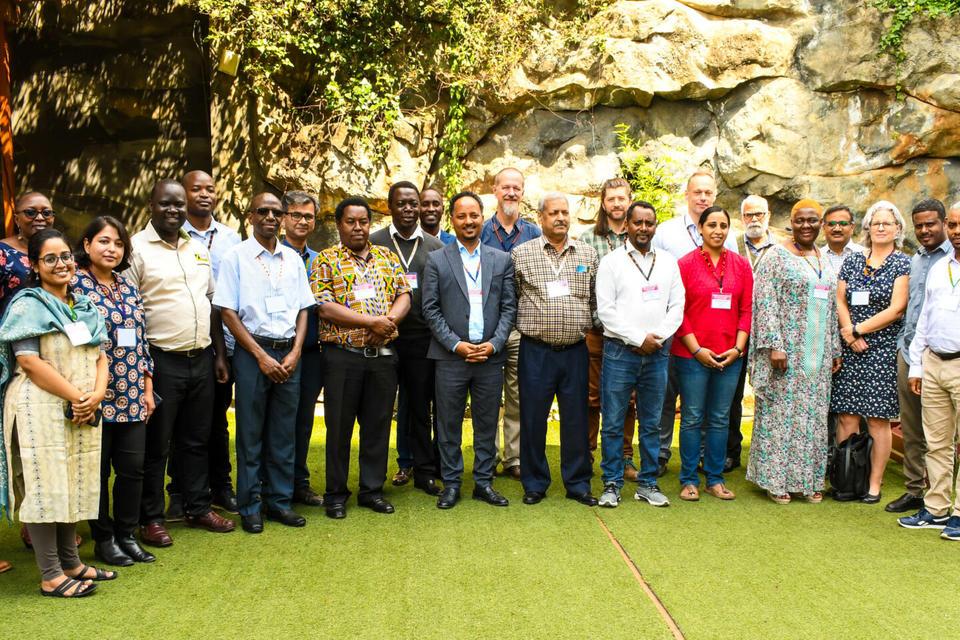From the Field Bundling Social Technical Innovations for a Diversification, Inclusive and Resilient Agri-Food System in Kenya

‘It was exciting attending the Nakuru Agricultural Show. I learnt a lot on how I can do my farming adapting to the changing climate’, commented Regina Chebii a Lead Farmer from Kapkatet Self Help Group in Visoi Ward, Rongai Sub-County, Nakuru. This is a common statement from most of the participants of the Nakuru agricultural show.
By: Eileen Nchanji, Boaz Waswa, Patrick Ooro, David Karanja and Edith Mutui (Editor)
Every year, since 1901, the Agricultural Society of Kenya (ASK) has organized agricultural shows in different towns in Kenya to expose stakeholders to emerging innovations, technologies and knowledge and business opportunities around agriculture and trade. The shows draw in diverse exhibitors among them the public, private sector, and other agricultural development partners, who showcase technologies and innovations around new crop varieties and livestock breeds, agro-inputs, best management practices, machinery, and value addition, among others. Thousands of farmers get an opportunity to meet and network amongst themselves and with various experts.
As has been the trend, Nakuru City was a beehive of activities in July as the County held its annual agricultural show whose theme this year (2023) was Promoting Climate Smart Agriculture and Trade Initiatives for Sustainable Economic Growth.
‘The theme of this year's show resonates well with the goal of Ukama Ustawi of diversifying and building resilient and inclusive agrifood systems in Kenya’, noted Dr. Patrick Ooro, the KALRO Njoro Ukama Ustawi Principal Investigator, as he welcomes participants to the KALRO Climate Smart Agricultural Village.
The KALRO stand was a great attraction, and was visited by over 5,000 attendees, of whom 389, comprising of 99 women signed the visitors’ book.
Kenya Agricultural and Livestock Research Organization (KALRO) and the Alliance of Bioversity International and the International Center for Tropical Agriculture (the Alliance) participated and showcased their activities at the Nakuru show as part of the OneCGIAR Initiatives, Ukama Ustawi and HER+. The initiative supported eighteen lead farmers, 5 males and 13 women from Ukama Ustawi learning sites in Nakuru to attend the agricultural show. The farmers visited the KALRO Climate-Smart Village stands, and other stands where they learnt about various climate-smart options ranging from crop varieties, innovative cropping systems, climate information services and mechanization.
Nakuru County is among the five learning sites in Kenya for the two oneCGIAR initiatives in Kenya. Ukama Ustawi (UU): Diversification for Resilient Agri-food in East and Southern Africa aims to help millions of smallholders intensify, diversify and de-risk maize-mixed farming through improved extension services, institutional capacity strengthening, targeted farm management bundles, policy support, enterprise development and private investment. On the other hand, The Gender Equality Initiative (HER+) initiative tackles gender inequality in agri-food systems to build climate change resilience in the Global South.
Ukama Ustawi activities in Kenya are coordinated by the Alliance of Bioversity International and CIAT and implemented by KALRO, Cereal Growers Association (CGA), Africa Conservation Tillage Network (ACTN), development and County Governments in target sites. In Nakuru County, KALRO Njoro is collaborating with the Alliance of Bioversity and CIAT, PAFID and the County Governments of Nakuru to scale out sustainable intensification and climate-smart agriculture practices to build resilience in the maize based system in 3 Sub-Counties: Njoro, Rongai and Gilgil where 6 mother demos have been established to enable learning by farmers and researchers.
The farmers attending the Nakuru Agricultural Show were taken through the stands to learn about the wide range of climate-smart technologies, innovations and management practices (TIMPs) developed by KALRO and partners.
We met Mr. David Karanja, a seasoned bean breeder at KALRO Katumani, talking to farmers about beans. David stresses the importance of adopting best management practices for growing common beans, among them use of the right variety for a given region, taking into consideration altitude, temperature and rainfall. He points to Nyota, a drought-tolerant, fast-maturing, high iron and zinc bean. Other improved varieties are Faida, Angaza, Metameta and Yellow-KATB1, which were developed in collaboration with the Pan Africa Bean Research Alliance (PABRA). He emphasizes the need to understand markets when going into bean production as a business. On display are value-added products like bean flour and pre-cooked beans as opportunities for agribusiness development and pathway to delivering nutrition to the households.
Nakuru being a maize growing area, the farmers visited a maize stand, where they were provided with information on the best maize varieties and their management options are best: spacing, innovative cropping systems such as rotation and intercropping, soil fertility and water conservation techniques, pest and disease management among other topics. A visit to the livestock section enabled the farmers to learn about various breeds and their management and how the manure can be used to improve soil fertility in an integrated crop-livestock system. Other stands visited were on agriculture mechanization, which is essential for wide adoption of conservation agriculture as well as reducing drudgery, especially for women and children.
A visit to the farmers’ fields in Rongai enabled further connecting lessons from the agricultural show to the practice on the farms, with the farmers sharing their experience on the ongoing learning Ukama Ustawi project. Rongai, like many parts of Nakuru County, has continued to experience recurrent droughts, more so mid-season droughts that result in crop failure even with a promising season. This calls for growing adapted maize and bean varieties, proper spacing and intercropping that also minimize competition and water management technologies such as ripping and use of animal manure.
“We have only one season, so we have to put our best foot, so we don’t lose everything”, Caroline Chepkorir said as she took the team around her farm, where she tried out some of the technologies.
Through the project, KALRO and the farmer groups in Nakuru have established mother demos in 6 wards to showcase diverse crop diversification technologies: monocropping, rotation and intercropping systems of maize and beans. Farmers noted the benefit of ripping in conserving soil moisture longer compared to conventional disk ploughing. Beyond the sole cropping, farmers preferred diversification using strip cropping, which involved planting four rows of beans alternated with four rows of maize. Strip cropping exhibited less competition between the maize and the beans while at the same time enabling both crops to yield higher compared to the 1:1 and 2:2 intercropping systems, which showed strong competition and were labour-intensive. The farmers around the demos have picked different technologies from the mother demonstration field to suit their needs, wants and in relation to their ability. Beyond maize, the farmers noted the potential for sorghum as a complementary climate-smart variety of choice. A combination of maize and sorghum is part of the diets in the community, so the adoption of sorghum-based technologies would receive wide acceptance as a crop diversification option.
Complementing biophysical technologies is the need to facilitate access to climate information services to make the right and timely decisions considering the changing climate. The farmers were trained to use the Kenya Agricultural Observatory Platform (KAOP), an application developed by KALRO to access short weather forecasts that is critical to inform planning.
‘Most farmers are elderly. They need more interactive and visual training approaches. I find the animations on beans very exciting and educative’, noted Mr. Willy Serem after viewing some of the animations on beans developed by PABRA.

Farmers at Kapkatet viewing the bean animations.
With a weak public extension system, there is a need to find ways of delivering knowledge and information to the farmers in a friendly manner. PABRA has developed a series of animations hosted on PABRA YouTube channel (2396) Common Bean Animation Series - YouTube. The animations cover various topics of bean production, post-harvest handling, agrobusiness, gender and school feeding that are now being used as interactive training tools. The animations have been translated into English, Kiswahili and French and are targeted for diverse audiences.
‘We need to ensure that the training tools are relevant to the target audiences. We have developed animations that are more pictorial and interactive. We plan to develop more of such tools for use under the UU sites in Kenya’, noted Dr. Eileen Nchanji, a Gender Expert from the Alliance of Bioversity International and CIAT and lead for HER+ WP 2 in Africa.
‘There is no single approach for facilitating learning by farmers’, Dr. Boaz Waswa, Lead UU Work Package 1 Kenya.
Scaling sustainable intensification requires bundling social, technical solutions and facilitating continuous learning and knowledge exchange among the stakeholders. UU and HER+ will continue to use the learning platforms to expose farmers to diversified, and inclusive climate-smart agriculture options in order to achieve resilient and productive agrifood systems.
This work was carried out with support from the CGIAR initiatives, Ukama Ustawi (UU): Diversification for Resilient Agri-food in East and Southern Africa, and, The Gender Equality Initiative (HER+), we would like to thank all the funders who support this research through their contributions to the CGIAR Trust Fund.
Learn more about initiatives in the CGIAR research portfolio
Related Content



